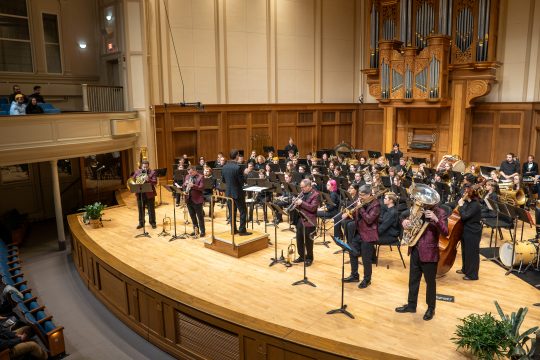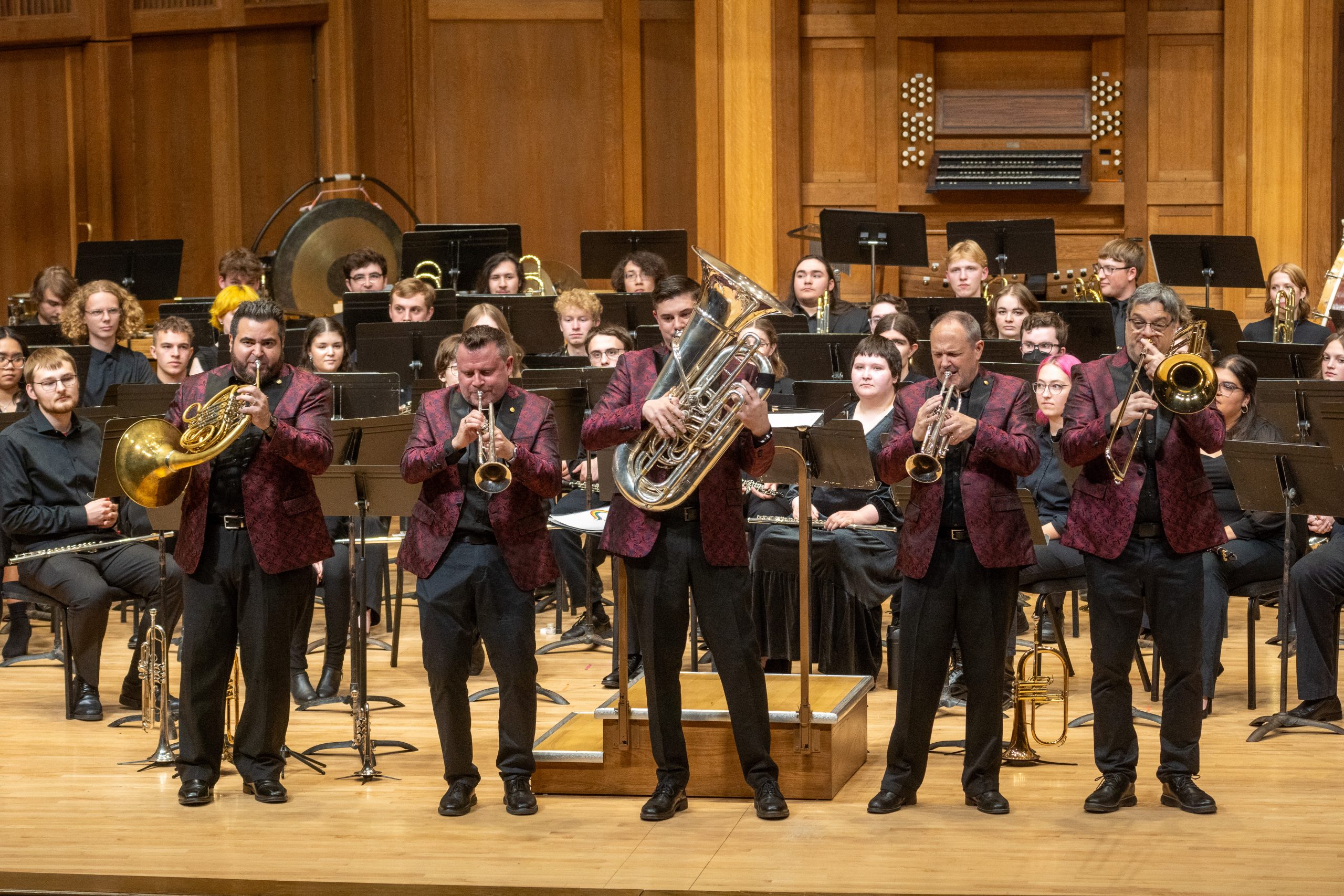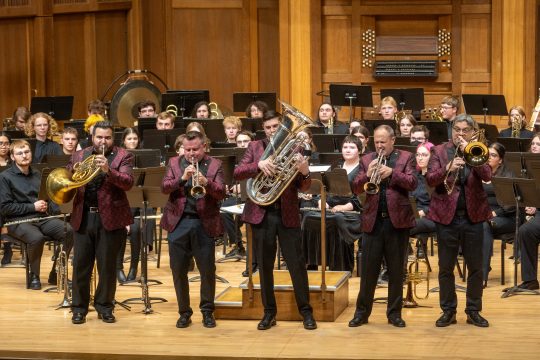Lawrence University’s Performing Arts Series is a staple of conservatory life. In recent years, it brought musical luminaries such as singer Samara Joy, as well as trumpeter Wynton Marsalis and his band. Rarely, however, do the guest artists join forces with an LU ensemble.
This past Saturday, Oct. 15, the Lawrence University Wind Ensemble and Symphonic Band were joined by the Boston Brass, a nationally renowned brass quintet that includes José Sibaja and Jeff Conner on trumpet, Chris Castellanos on horn, Domingo Pagliuca on trombone and tubist William Russell.
To open, the Wind Ensemble played J.S. Bach’s “Passacaglia and Fugue in C minor, MWV 582” under Andrew Mast, the Associate Dean of the Conservatory, Kimberly-Clark Professor of Music and Director of Bands. The ensemble traded off quick contrapuntal lines with remarkable cohesion.
“As you can probably guess,” said Mast, “the Passacaglia and Fugue was originally written for organ” in the early 18th-century. Indeed, the arrangement by Donald Hunsberger properly translates the organ’s brittle and stoic nature into band music.
For the next work, the ensemble jumped nearly three centuries to perform “The Red Balloon,” written in 1993 by Anne McGinty. It is based on a painting of an old man and child with a balloon, which moved the composer on her first viewing.
“The materials are simple — which is not the same thing as easy — and the composition is a masterpiece,” said Mast. Although originally written for an elementary school, Mast explained that “when this came out […] I was so taken by it that I was like, ‘I can’t wait to do that piece with an ensemble that can really do it justice.’”
Fortunately, the group lived up to Mast’s hopes, delivering a wholly evocative performance. Senior Sudha Schultz’s reccurring trumpet solo was a particular highlight: she brought a consistently gentle yet engaging lyricism to the line. Senior Graham Goland also brought a sensitively-timed glockenspiel part, which never strayed from the ensemble.
For Rick DeJonge’s “Introduction and Vivace,” the Boston Brass joined the Wind Ensemble onstage. A colorful and exciting work, the quick and frequent transitions between chamber and symphonic textures were a fascinating sound not often heard in large ensemble works.
The Boston Brass now engaged in a three-piece program of their own. Their standing formation — horn, trumpet, tuba, trumpet, trombone — put a hugely satisfying prominence on the deep resonance of the tuba. They began with Dimitri Shostakovich’s “Galop,” a fast-paced jig that ended with a unison, “Hey!” out loud.
Instead of the originally planned Khachaturian work on the program, the group performed Bach’s “Wachet auf, ruft uns die Stimme,” among the composer’s best-known cantatas. Originally for voices and a chamber ensemble, the arrangement showcased the moving melodicism of José Sibaja in a lengthy solo. Although the tuba is not often known for its lyricism, it gave an impressively smooth accompaniment in the hands of William Russell.
Astor Piazzolla’s “Verano Porteño” was next, in the tango style which the composer specialized in. It was originally for the bandoneon, described by Sibaja as “sort of like related to the accordion, but actually cool.”
Unlike their previous selections, the Piazzolla alternated between a rhythmic and laid-back style, instead of sticking to one. At one point, two of the members began body percussion, before quickly switching to a slower passage.
Symphonic Band’s portion began next, under the baton of Matthew Arau, Lawrence’s Assistant Professor of Music, Chair of the Music Education Department and Associate Director of Bands. The ensemble began with Katahj Copley’s “Halcyon Hearts: An Overture for Love,” a tuneful piece with a Disney-like aesthetic.

The subsequent “Lord Tullamore” by Carl Wittrock was described by Arau as “Irish-inspired music.” With a spot-on dual drum duet from third-year Jacob Hanekamp and first-year John Henderson, the music sprang into action.
“[This is the] first occasion where I’ve done a piece a second time,” commented Arau on the penultimate work. It was “City Trees” by Michael Markowski, played by the Symphonic Band with genuine dedication and expression.
The Boston Brass returned to join the Symphonic Band, both of which commissioned the concert’s final performance. “Perplexing Times” by Grammy-winning composer Gordon Goodwin is a peculiar amalgamation, combining brass quintet, rhythm section and a large band. The impressive and coloristic work was incredibly well-received by the audience.
In a fit of excitement, the Boston Brass added an encore: Duke Ellington’s “Caravan.” The immense virtuosity on display extended to every performer and was a thrilling end to the successful evening.


